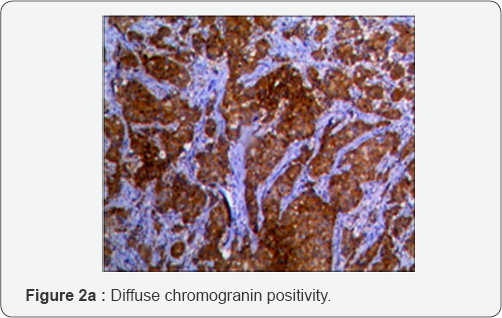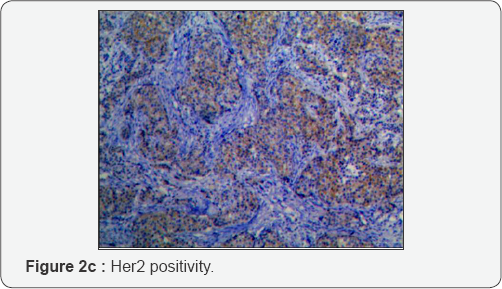Primary Neuroendocrine Carcinoma of the Male Breast: a Rare Case Report
Manupriya Sharma*, Aruna Gupta, Suman Singh and Rashmi Kaul
Dr. Rajendra Prasad Government Medical College Kangra, India
Submission: October 02, 2017; Published: November 14, 2017
*Corresponding author: Manupriya Sharma, Dr. Rajendra Prasad Government Medical College Kangra, House No. 12, Type 5, E block, India, Tel: 8628000105; Email: manupriya.priyasharma@gmail.com
How to cite this article: Manupriya S, Aruna G, Suman S, Rashmi K. Primary Neuroendocrine Carcinoma of the Male Breast: a Rare Case Report. JOJ Nurse Health Care. 2017; 5(3): 555661. DOI: 10.19080/JOJNHC.2017.05.555661
Abstract
Introduction: Primary Neuroendocrine (NE) Carcinoma, male breast is an extremely rare malignancy. NE breast carcinomas comprises of a heterogeneous group of tumors which exhibit morphological features similar to NE tumors of gut and lungs. This case highlights the clinical features, histogenesis and diagnostic criteria of this extremely rare entity.
Case report: A 55-year old male with breast lump was diagnosed with NE carcinoma on histology and further confirmed on immunohistochemistry (Chromogranin A). The tumour was graded high grade based on the presence of necrosis, lymph vascular invasion and lymph node metastasis. Thorough clinical and radiological evaluation of the patient ruled any extra mammary primary tumour. Contrary to previous reports, Her2 revealed immunoreactivity in our case.
Summary and conclusion: Male breast carcinomas are usually located in subareolar region. Immunohistochemistry (IHC) is the gold standard for the confirmation of NE carcinoma. Grading of NE carcinomas is important for proper management and prognostication of the patients. Contrary to previous reports, Her2 may be positive in NE carcinoma, breast.
Keywords: Neuroendocrine (NE) carcinoma; Male breast; Immunohistochemistry (IHC); Chromogranin
Introduction
Primary neuroendocrine (NE) carcinoma of the breast is an uncommon variant of extra pulmonary NE Carcinoma with an incidence of around 1%. Majority of these cases have been reported in females. NE carcinoma in a male breast is an extremely rare entity with only few case reports [1]. NE tumours of breast include a heterogeneous group of tumor which exhibits the same morphological features as their counterparts in lungs and GIT. These tumors show >50% immune reactivity to one or more of the NE markers (neuron specific enclose, chromogranin and synaptophysin) which help to clinch the diagnosis [2].
We report a case of primary NE carcinoma, breast in a male that was diagnosed preoperatively as duct cell carcinoma by fine needle aspiration cytology (FNAC). Subsequently on histology and IHC, the case was reported as NE carcinoma. Through this case we discuss the clinical features, histogenesis and diagnostic criteria of this rare entity.
Case Report
A 55-year-old male reported to the surgery OPD with a self detected mass in the right breast. On examination, the lump was located in the subareolar region, and was about 3cm in diameter. The lump was hard in consistency and was not fixed to the overlying skin and underlying tissue. No lymph nodes were palpable in the axilla. Breast ultrasound showed an ill defined mass measuring (2x1.8x1.5)cm with non uniform internal echo. The patient was advised FNAC of the breast lump. The aspirate from the lump was hemorrhagic. Smears examined were moderately hyper cellular and showed dyscohesive clusters of malignant cells. These cells showed moderate pleomorphism, coarse nuclear chromatin and moderate cytoplasm. No mitosis was noted in the cytology smears examined. Based on these cytological features, a diagnosis of invasive ducal carcinoma was suggested. The patient underwent radical mastectomy and the specimen was submitted for histopathological examination. On gross examination, the respected mass measured (14x9x3) cm. On serial sectioning, a growth measuring (2x2x1.8)cm was identified in the central quadrant. The growth was firm to hard in consistency and grey white in color. No areas of necrosis or hemorrhage were identified. Multiple sections were taken from growth and examined. Sections examined showed a tumour with cells arranged in nests separated by fibrovascular stroma (Figure 1a). Cells showed moderate anisonucleosis, stippled ('salt and pepper') chromatin and moderate amount of granular eosinophilic cytoplasm (Figure 1b). Tumour cells revealed 4/10hpf mitotic count Peripheral (Figure 1a). Palisading of the tumour cells was noted at places. Some of tumour nests showed comedo-necrosis Tubule formation was not noted. Lymphovascular emboli were seen. Seven axillary lymph nodes were identified in the axillary tail. Three lymph nodes revealed tumour deposits. Morphologically, the tumour revealed a characteristic nested pattern of growth and the tumour cells showed salt and pepper chromatin with moderate amount of granular eosinophilic cytoplasm. Furthermore, the tumour showed evidence of necrosis, mitotic count of 4/10hpf, lymphovascular invasion and lymph node metastasis. Based on these findings, a possibility of high grade NE Carcinoma was kept and Immunohistochemistry (IHC) for NE markers was advised. IHC revealed tumour cells to be positive for chromogranin (Figure 2a). The final diagnosis of high grade NE Carcinoma was made. Further, Estrogen receptor (ER)/ Progesterone receptor (PR) and perception positivity was evaluated. The tumour cells revealed diffuse ER positivity (Figure 2b). The tumour cells revealed immunoreactivity to Her2 and were negative for PR (Figure 2c,2d). Further, it was important to exclude any extra mammary origin of the NE carcinoma and metastasis to the breast. Hence, patient had a thorough clinical and radiological workup (CT scan, PET-CT, USG abdomen) and this possibility was ruled out. Post-surgery, patient was put on adjuvant chemotherapy and radiotherapy. Patient is still under clinical follow up without any evidence of metastasis.






Discussion
Breast carcinoma is an uncommon neoplastic condition among men, accounting for not more than 1% of all breast carcinomas. Worldwide, the incidence of male breast carcinoma is generally less than 1 case/lLakh men per year. 85% of the male breast carcinomas are invasive ductal type [3] NE Carcinoma is a rare variant of carcinomas in male breast. Secondly, these rare cases of NE Carcinoma will be mainly metastasis from other primary sites (lungs and GIT). Primary NE Carcinoma, male breast in an extremely rare malignancy described in literature with only a handful of reports [4,5]. According to 2003 World health organization (WHO) classification, mammary NE carcinoma are defined as carcinomas with more than 50% expression of NE markers in tumour cells [6]. In 2012, WHO revised this category and divided NE carcinomas into three subtypes:
1. NE tumor, well-differentiated.
2. NE carcinoma, poorly differentiated/small cell carcinoma.
3. Invasive breast carcinoma with NE differentiation [7].
The index case showed classical nesting pattern of tumor cells with salt and pepper chromatin and peripheral palliating of tumour cells. These features are characteristic of a NE malignancy. For confirmation of a NE carcinoma, IHC with NE markers is the gold standard. Chromogranin A, chromogranin B, and synaptophysin are considered the most sensitive and specific NE markers for this condition [8]. In our case, the tumour cells revealed diffuse positivity for chromogranin A. The tumour cells revealed diffuse positivity for ER. Tumour cells were negative for PR. Contrary to previous reports, the tumour cells revealed immunoreactivity to Her2. Previously, this finding has been reported only by Jiang et al [5]. There are no consistent reports on ER/PR positivity in NE carcinomas and the positivity ranges from 0% to 85% [9,10]. Positivity for chromogranin A confirmed the tumour as NE carcinoma. In order to confirm the carcinoma as Primary NE carcinoma, it is important to thoroughly investigate the patient to rule out any non- mammary primary site or to identify an in situ component of the tumour histological. In the index case no primary tumour was identified elsewhere on thorough clinical and radiological work up. However, no in situ tumour component could be identified histological. Based on these findings, this case was reported as Primary NE Carcinoma. The histogenesis of primary NE carcinoma is still unclear, because the presence of NE cells has not been proved conclusively. It has been suggested that NE carcinomas may be a variant of metaplastic carcinoma, breast [1].
It has been seen that male breast carcinomas are usually high grade with more evidence of vascular and lymphatic permeation [3]. The index case revealed high grade tumour features in the form of come do necrosis, lymph vascular invasion and lymph node metastasis. It is important to grade the neuroendocrine carcinomas [7] for proper treatment decisions and prognostication of the patient.
Conclusion
NE carcinoma in male breast is an extremely rare entity. It is important to distinguish primary NE carcinoma from metastatic neuroendocarine carcinoma due to the differences in the management protocols. IHC is the gold standard for the confirmation of NE carcinoma. Contrary to previous reports, this case also highlights the fact that NE carcinomas may show positivity to Her2. Pathologists should include the grading of NE carcinomas in the final diagnosis as it plays an important role in prognostication of the patients and taking management decisions.
References
- Klimstra DS (2013) Pathology reporting of neuroendocrine tumors: essential elements for accurate diagnosis, classification, and staging. Semin Oncol 40(1): 23-36.
- Rovera F, Masciocchi P, Coglitore A, La Rosa S, Dionigi G, et al. (2008) Neuroendocrine carcinomas of the breast. Int J Surg 6 (Suppl 1): S113-S115.
- Ruddy KJ, Winer EP (2013) Male breast cancer: risk factors, biology, diagnosis, treatment, and survivorship. Ann Oncol 24(6): 1434-1443.
- Lingappa HA, Indushekar V, Chamarthy NP, Soni A (2014) Primary neuroendocrine carcinoma of male breast: A cytologically diagnosed rare entity. J Cytol 31(2): 105-107.
- Jiang J, Wang G, Lv L, Liu C, Liang X, et al. (2014) Primary small-cell neuroendocrine carcinoma of the male breast: a rare case report with review of the literature. Onco Targets Ther 7: 663-666.
- Ellis P, Schnitt SJ, Garau SX, Tavassoli FA, Deyilee P, et al. (2003) Invasive breast carcinoma. Tumors of the Breast and Female Genital Organ: Pathology and Genetics. Lyon, IARC Press, France.
- Lakhani S, Ellis I, Schnitt S, Tan P, van de Vijver MJ, et al. (2012) WHO Classif. Tumours Breast, IARC Press, France, pp. 62-63.
- Jundt G, Schulz A, Heitz PU, Osborn M (1984) Small-cell neuroendocrine (oat cell) carcinoma of the male breast. Immunocytochemical and ultrastructural investigations. Virchows Arch A Pathol Anat Histopathol 404(2): 213-221.
- Shin SJ, DeLellis RA, Ying L, Rosen PP (2000) Small-cell carcinoma of the breast: a clinicopathologic and immunohistochemical study of nine patients. Am J Surg Pathol 24(9): 1231-1238.
- Adegbola T, Connolly CE, Mortimer G (2005) Small-cell neuroendocrine carcinoma of the breast: a report of three cases and review of the literature. J Clin Pathol 58(7): 775-778.






























